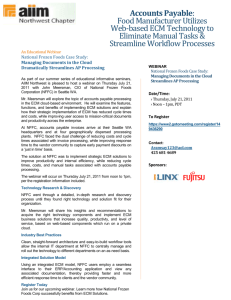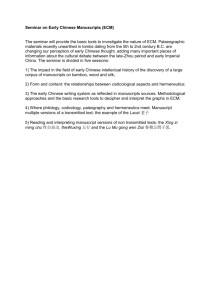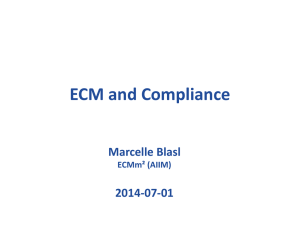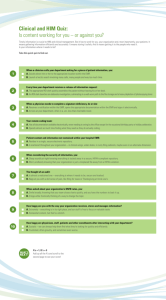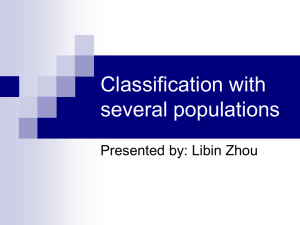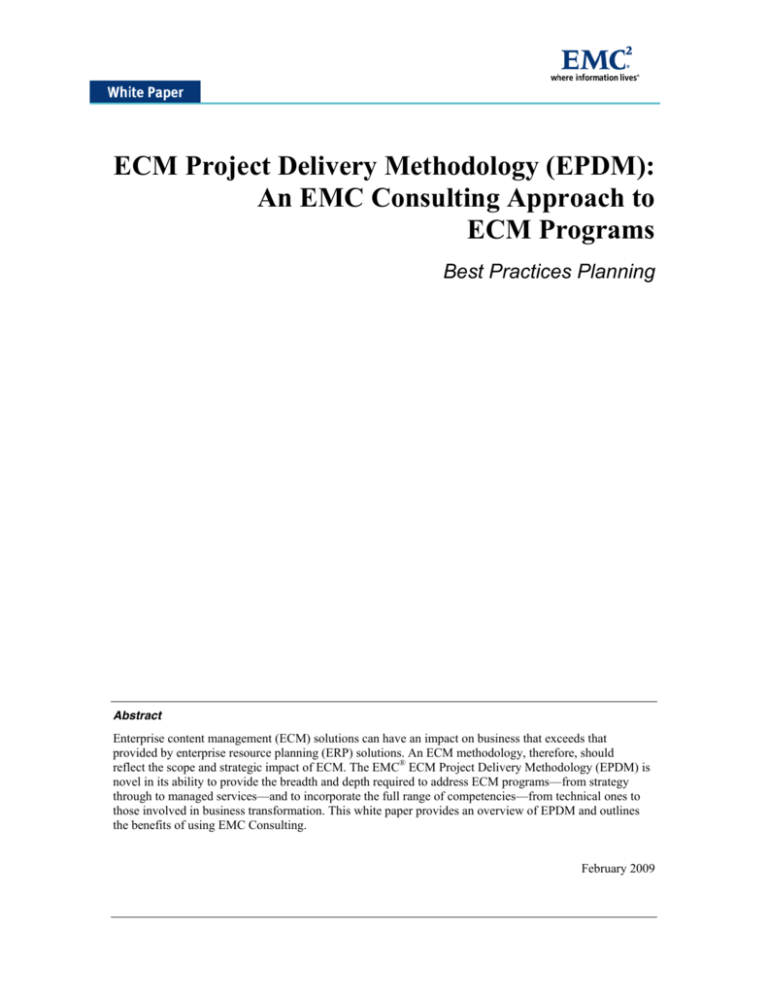
ECM Project Delivery Methodology (EPDM):
An EMC Consulting Approach to
ECM Programs
Best Practices Planning
Abstract
Enterprise content management (ECM) solutions can have an impact on business that exceeds that
provided by enterprise resource planning (ERP) solutions. An ECM methodology, therefore, should
reflect the scope and strategic impact of ECM. The EMC® ECM Project Delivery Methodology (EPDM) is
novel in its ability to provide the breadth and depth required to address ECM programs—from strategy
through to managed services—and to incorporate the full range of competencies—from technical ones to
those involved in business transformation. This white paper provides an overview of EPDM and outlines
the benefits of using EMC Consulting.
February 2009
Copyright © 2009 EMC Corporation. All rights reserved.
EMC believes the information in this publication is accurate as of its publication date. The information is subject to change without
notice.
THE INFORMATION IN THIS PUBLICATION IS PROVIDED “AS IS.” EMC CORPORATION MAKES NO
REPRESENTATIONS OR WARRANTIES OF ANY KIND WITH RESPECT TO THE INFORMATION IN THIS PUBLICATION,
AND SPECIFICALLY DISCLAIMS IMPLIED WARRANTIES OF MERCHANTABILITY OR FITNESS FOR A PARTICULAR
PURPOSE.
Use, copying, and distribution of any EMC software described in this publication requires an applicable software license.
For the most up-to-date listing of EMC product names, see EMC Corporation Trademarks on EMC.com
EMC2, EMC, and where information lives are registered trademarks of EMC Corporation. All other trademarks used herein are the
property of their respective owners.
Part Number h4615
ECM Project Delivery Methodology
Best Practices Planning
2
Table of Contents
Executive summary ............................................................................................ 4
Introduction ......................................................................................................... 4
Audience ...................................................................................................................................... 4
The structure of EPDM ....................................................................................... 4
Use of industry standards.................................................................................. 5
The program context .......................................................................................... 6
The Project Management Framework ............................................................... 6
Streams and ECM program expectations ......................................................... 7
Overview of principal project types .................................................................. 9
ECM roadmap study .................................................................................................................... 9
Solution development ................................................................................................................ 10
Solution deployment .................................................................................................................. 12
Solution support ......................................................................................................................... 13
Practice materials ............................................................................................. 15
Conclusion: The benefits of EPDM ................................................................. 16
ECM Project Delivery Methodology
Best Practices Planning
3
Executive summary
The purpose of the EMC® ECM Project Delivery Methodology (EPDM) is to define a repeatable, industryleading approach to providing solutions and services that assures high-quality delivery and customer
satisfaction. The methodology significantly enhances the ability of EMC to deliver enterprise deployment
programs and extends the breadth and value of EMC service offerings beyond the traditional technical
focus of the ECM marketplace. The EMC methodology is unique in its combination of ECM best practices
and a wide range of relevant and targeted industry standards.
The principles of EPDM are:
•
EPDM is comprehensive, adaptable, and scalable to the range and size of projects and services EMC
Professional Services provides.
•
EPDM uses collaborative techniques to continually incorporate EMC knowledge and experience from
all parts of the consultancy organization.
•
EPDM is delivered, maintained, and presented in a way that makes it extensible, functional, and
maintainable.
•
EPDM draws on techniques that have been proven to ensure best-of-breed quality that is respected
within EMC and by its clients.
The problem with traditional methodologies is that they are often either too generic (so offer nothing to the
consultant within a specific competency area) or are too specific (focused on a particular solution or
industry domain). Examples of traditional methodologies that are not broadly applicable to ECM include:
•
“Me Too”: Dealing with generic aspects of any design process (analyze, design, build) and project
management. Focused on process rather than content, and lacking “how to” for specific contexts within
ECM
•
“By Numbers”: A numbered step-by-step approach (101, 102, etc.) that is neither flexible nor
extensible
•
“Service Packaged”: Associated with a specific service offering or point solution, often including a
bundle of project management as well as guidance on execution. Not scalable to the full range of ECM
program needs
Introduction
This white paper provides an overview of EPDM, including its structure, use of industry standards, and
solution development, deployment, and support. It also outlines the benefits of using EMC Consulting.
Audience
This white paper is intended for prospective and existing EMC enterprise content management customers,
as well as ECM consultants and partners.
The structure of EPDM
The ECM Project Delivery Methodology uses a novel three-tiered approach combining the following
elements:
•
Project Management Framework (PMF): The controls applicable to any project type, based on the
industry standard Project Management Institute (PMI).
ECM Project Delivery Methodology
Best Practices Planning
4
•
Project-type routemaps: These routemaps include work breakdown structures (WBS) for principal
project types (the “what”) and key overall guidance on use of these routemaps. The aim is to reuse
wherever possible, but also to refine when necessary.
•
Practice materials: The evolving body of knowledge (the “how to”), including critical elements in the
methodology such as activity guidelines (see the “Practice materials” section on page 15).
EPDM is designed to be relevant, flexible, and scalable. Project types can evolve and practice materials can
expand or diversify to deal with a wide range of project type variables: activity, competency/discipline,
role, sector, solution, and others.
The EPDM structure is illustrated as follows:
Project Management Framework
PM Support
Project Type Routemap
Project
Type
Routemap
Type
Routemap
- WorkProject
Breakdown
Structure
(WBS)
Pr
Ty oje
pe ct
s
Project
Manager
- Work Breakdown Structure (WBS)
- Work
Breakdown Structure (WBS)
- Project
Life-cycle
- Project Life-cycle
- Project Life-cycle
Tier 1
PM Reporting
Select/ Refine Project Type
Routemap (based on standard) - Project Management Structures
- Project Management Processes & Controls
Guide to PM Planning Project
kS
eq
ue
nc
in
g
PM Controls
Ta
s
Referenced Practice
Materials related to
Activities and Roles
Practice Material
Guidelines, Deliverable Templates,
Practice Aids, White Papers, etc.
relating to wide variety of topics
Task Reporting
Tier 2
Solution
Guidance & Tools
Re-usable Deliverables
Tier 3
Project
Team
Figure 1. EPDM three-tier structure
Most methodologies focus on project management (i.e., Tier 1), and therefore offer too little on the “what”
and “how to,” or provide an overly prescriptive “by numbers” approach to the latter two elements that is
neither flexible nor scalable.
Use of industry standards
Where appropriate, the aim is to reuse external as well as internal standards and best practices. External
generic standards (not specific to ECM) include:
•
PMI: Used as basis for the Project Management Framework
•
IT Infrastructure Library (ITIL): Used for processes related to support and associated management
•
Modern or “agile” approaches to software development applicable in a COTS environment: Examples
include Dynamic Systems Development Method (DSDM)
ECM Project Delivery Methodology
Best Practices Planning
5
External standards highly relevant to ECM include:
•
Records management standards such as MoReq
•
Controlled vocabulary standards such as for a mono-lingual thesaurus (ANSI/NISO Z39.19-2005 or
ISO 2788)
•
Markup standards such as XML
Some standards are industry-specific and have significant ECM implications. For example:
•
Schemas used to model content: XBRL, NewsML and eCTD are examples of XML schemas for
business reporting (accounting sector), multi-media news (media sector), and the Common Technical
Document for dossier submissions (pharmaceuticals sector)
•
Regulatory compliance: Basel II in Finance; 21 CFR 11 in Pharmaceuticals; and SOX as cross-industry
regulation
Often, as above, ECM-related requirements are embedded in a broader set of standards.
The program context
Projects should have clear outcomes and deliverables. Programs that encompass multiple projects that have
been clearly scoped also contain broad aims and objectives that will only be fully met by yet-to-be-defined
projects. The program manager has to deal with ambiguity, uncertainty, and complex environments where
stakeholders and governance are in flux. However, the program manager can still use the PMF when
managing a program under EPDM.
The Project Management Framework
The PMF is based on the international standard PMI (www.pmi.org). It includes a wide range of processes
organized into five process groups:
•
Initiating
•
Planning
•
Executing
•
Controlling/monitoring
•
Closing
ECM Project Delivery Methodology
Best Practices Planning
6
Initiating
•
•
•
•
Planning
•
•
•
•
Scope (Change) Management
Status Reporting
Delivery Manager Review
Country Manager/ Regional
Director Reviews
Stage Gate Review
Cost & Revenue Management
Issue/Risk Management
Schedule Management
Resource Management
Stakeholder Management
Controlling/
Monitoring
Bus. Ops Billings &
Invoicing Processes.
Administrative Sales &
Bus. Ops - closure
processes complete.
Closing
•
•
•
•
•
•
•
•
•
Refine Work Breakdown
Structure
Refine Project Life-cycle
Project Planning
- inc. Resources and Schedule
Communication Plan
Risk Plan
Issue (Escalation) Plan
Scope (Change) Plan
Quality Planning
All hands kick off
•
•
•
•
•
•
•
•
Project
Gates
Executing
•
•
•
•
•
Ensure Delivery Management
engaged
PM Engaged
Knowledge Transfer
Produce Charter, inc.
- Governance / escalation
- Deliverables checklist
Stakeholder Analysis
Team Assigned
Internal Kickoff
Execute Plan
Utilize Reusable Assets
Complete Work Packages
Create Reusable Assets
Use Project Type Specific
Practice Materials
Project Signoff
Acceptance criteria met
Client Feedback / Lessons learned
Project Archival
Project Staff Appraisals
Update appropriate skills matrix and Resumé
Harvest reusable materials
Follow-on opportunity
Customer reference
KEY
Process Group
Delivery Management and Program Management: Governance and Quality
•
•
•
Sales & Bus. Ops Contractual initiation
processes complete.
•
•
•
•
•
•
Deliverables
Customer
•
Project Manager responsibilities
Sales & Bus. Ops. Processes
Work Packages & Deliverables
Figure 2. PMI process groups and deliverables
Each process group includes artifacts related to:
•
Processes (for example, budget management)
•
Deliverables (for example, risk plan)
•
Key events (for example, project sign-off)
Some of the processes are internal to the project—helping the project manager get a good result—but are
not necessarily project management deliverables intended for the client.
Streams and ECM program expectations
Any project (or program), and in particular those associated with enterprise content management solutions,
is comprised of a number of elements in addition to the technical ones. EPDM goes beyond the normal
triad of “people, process, and technology” to include the following streams:
•
Benefits
•
Process
•
Functional/application
•
Content/information
•
People/change
•
Technology/infrastructure
ECM Project Delivery Methodology
Best Practices Planning
7
Governance and Program Management
BAU
Principal Project Types
Solution Development
ECM Roadmap Study
(Strategy)
Application
Development
Life-cycle
Solution
Support
(incl. establishment
of BAU processes)
Detailed analysis of
benefits and KPIs.
Features traceable from
Benefits.
Stakeholders
managed and
benefits baselined.
Benefits are being
measured and
demonstrated.
Approach and ‘process
architecture’ agreed
AsIs and ToBe process
analysis.
Workflows designed.
New processes
established.
Process monitoring
and improvement.
Identify and prioritise
applications.
Understand prioritised
requirements for an
application
Iterative and collaborative
functional-design-test
process.
Role based training
delivered
Effective
application support
processes.
High level information
requirements and policies
Define meta-data strategy
and information
architecture.
Design object model, data Content is migrated
dictionary and controlled
and indexed.
vocabularies.
Standards and
procedures in place.
Long-term content
issues being
addressed
Understand / plan change
management challenge.
Assess training needs
and develop strategy
Ensure the requirements
reflect the strategic aims.
Project team trained in
EMC products/ solutions
Usability and TCO issues
are addressed.
Solution training for UAT
& Deployment roles
Sustainable change
being executed.
Training for end-user
& support roles.
On-going training
for new staff or staff
changing roles.
Maintain training.
Technology strategy
Technology/ aligned to client’s IT aims
Infrastructure
Non-functional
requirements understood.
Define development, test
and operational
environments.
Scalable &
performance
infrastructure in
place.
ITIL processes in
place
Process
Functional/
Application
Content /
Information
People/
Change
Quality Management
Figure 3. Program streams
Each stage in the program lifecycle addresses these streams to refine details related to the different streams.
A rush to build should be avoided. For example, designing an object model, or even a metadata strategy,
prior to IM policies engages the wrong stakeholders too early.
Figure 3 summarizes the key objective of each stream for each (principal) project type. Varying emphasis
may be applied (for example, process stream has greater weight for BPM solutions) but all streams are
important to consider in all cases.
ECM Project Delivery Methodology
Best Practices Planning
8
Transformation Achieved
Stakeholders engaged.
High level benefits case
agreed.
Benefits
Streams
Business
Requirements and
Analysis
Solution
Deployment
Overview of principal project types
The principal project types enable an ECM program to evolve from strategy to managed support and
services, and are illustrated as follows:
ECM Roadmap Study
Refine Detail by Stages
Strategic
Requirements
Solution
Vision
Change
Management
Strategy
Business Case
ECM Roadmap
Solution Development
Business
Requirements
and Analysis
Solution
Specification
Solution
Design
Test Solution
Build Solution
Solution Deployment
Implementation
Plan
Change
Management
Plan
Commitment
Deployment
Preparation
Deploy
Solution
Deliver
Change
Confirm
Benefits
Solution Support
Support
Requirements
& Plan
Support
Model
Support
Processes
Support
Operations
Transition
to Support
Initiate
Support
Stage Life-cycle
Figure 4. Principal project types
ECM roadmap study
The aim of an ECM roadmap study is to answer the key questions:
•
Why are you doing this ECM program?
•
What will the “future state” and “success” look like in business terms (over of the planning horizon
you have set)?
•
How do you get there (what initiatives and projects, and when)?
Example questions that a business must answer in relation to an ECM program:
•
Are you struggling to develop a roadmap to implement ECM across the business?
•
Are you developing point solutions that are re-creating information silos?
•
Are your projects locked into technical issues that are obscuring the key business questions?
•
Have you over-customized your applications and made it costly to roll out and maintain?
•
Are you interested in using EMC content management and archiving (CMA) best practices, embodied
in a solution, as a starting point?
ECM Project Delivery Methodology
Best Practices Planning
9
If the answers are “yes” to these types of questions, then a strategic approach provided by an ECM
roadmap study may well be the next step needed to take the ECM program forward.
Top-Down
business drivers, highlevel requirements,
change challenges,
priorities, etc.
Interview
process &
templates
Bottom-up
Analyse current
state – issues &
applications
High-Level Analysis of
Information Requirements
Key Integration
Requirements
Process Architecture
and Approach
Application
Analysis
Strategic
Requirements
Solution
Presentation
Candidate solution(s)
ECM Maturity
Model
ECM White
Paper(s)
Business and Logical
Architectures
Solution
Vision
ECM
Roadmap
ECM Benefits
Model
High Level
Business
Case
High-Level
Gap Analysis
Education &
Training
Resources
Change
Management
Strategy
KEY
Work Packages
Business
imperatives & IT
dependencies
Analysis Activities
supported by Practice Aids
Requirements
Figure 5. ECM roadmap study
Solution development
The aim now is to develop the application or solution. Ideally, it is one that has been identified in an ECM
roadmap study and is required to achieve an overall solution vision.
The solution development project type, while superficially similar to a traditional IT development project,
differs in three key aspects:
•
Being a COTS project, based on an initial CMA solution, the philosophy is to blend business
requirements and best practices (for example, using a gap analysis), using expertise on the art of the
possible and solution capabilities. The alternative—defining requirements from scratch—can lead to
excessive customization without a commensurate business benefit.
•
The emphasis is to refine rather than define the solution specification and other project artifacts related
to a solution.
•
Key aspects that relate to the domain of ECM (for example, information architecture as opposed to
data model) take on an ECM-centric view of the traditional lifecycle artifacts.
Our approach to solution development applies whether it is a point solution or an enterprise application. It
also applies even where the client has decided to stay very close to an existing CMA PS solution, because
the aim of the process is to validate that there are no gaps that need to be addressed and that the solution is
refined to address these gaps. The development process for an application or solution applies to each of the
identified solutions (in turn). It is important not to skip steps in the process even when only minor
refinement is needed.
A high-level view of the main work packages:
•
Business requirements analysis (BRA)
! Includes functional prototypes or mock-ups
ECM Project Delivery Methodology
Best Practices Planning
10
•
Refine/define solution specification
•
Refine/define solution design
•
Configure/build solution
•
Test solution
Business
Requirements Analysis
User
Acceptance
Testing
UAT Test
Cases
(see separate Functional
Prototyping diagram)
System
Test Cases
Refine / Define
Solution Specification
Refine / Define
Solution Design
Integration
Test Cases
System
Testing
Integration
Testing
Test Solution
Configure / Build
Solution
Figure 6. Solution development
Focus should not be placed exclusively on the functional/application stream. A balanced approach should
be taken to all streams. For example:
•
The benefits case for a solution can be undermined if it becomes more complex than is required (for
example, failure to address the 80/20 rule) and this then has an impact on the acceptance of the
solution or subsequent adoption, and may also cause maintenance issues.
•
The lack of the right mix of skills to address both process and content issues can manifest itself in
various ways (for example, a process solution that reflects best practices in BPM terms but then fails to
leverage product capabilities in the content management area).
•
Specific effort is required in ensuring a rigorous approach to non-functional testing, and requires
suitably scaled test environments and properly prepared and sufficient volumes and/or transaction rates
for test data and content.
•
A failure to involve people and change issues even during this predominantly software-focused phase
of work can undermine confidence in the solution.
ECM Project Delivery Methodology
Best Practices Planning
11
Reference Solution
Specification
(Functional)
Time-Box for
Increment
PRL Process
Refine PRL Complexity
Values and MoSCoW
Priorities as appropriate to
maximise total (Business
Value/ Complexity) ratio
XN
Increments
Increment
Analysis
Refine
Notes
PRL (Prioritised
Requirements List)
Refine PRL
Plan Time-Boxed
Increments for
Prototyping
Increment
Prototype
Increment
Review (Gate)
Capture
Specification
Notes
Capture Design
Notes
SDLC
(see main
Routemap)
Refined Solution
Specification
Refined Solution
Design
Compliance Requirements
Gap Analysis
(Detailed)
Solution Capabilities
Product
Capabilities
Reference Solution
Design
Figure 7. Functional prototyping or mock-ups
The purpose of functional prototyping is to support the business requirements analysis stage of the solution
development phase. This can be done by using working prototypes, but if the clarification can be achieved
using white boarding, story boarding, or mock-ups, then that is a valid approach if it is supported by
practitioners who fully understand the art of the possible.
The recommended approach to functional prototyping is to use an iterative project lifecycle, but to do so
within a structured environment with the following features:
•
Time-boxed: Each iteration has clear objectives and the imperative is to complete the iteration within
the specified time-box and therefore reduce or defer functionality if needed.
•
Multi-disciplinary: The relevant skills and expertise from both EMC and the client, including those
who understand the software (product and/or solution), business process, content/metadata, nonfunctional requirements, scope of testing, and others, are involved in the process.
•
Business-focused: Any changes to a solution or underlying software are only performed if they can be
justified on cost-benefit grounds. The more complex a customization, the greater the level of benefit
needed to justify the change.
Solution deployment
The deployment itself may be phased according to geographical, functional, and other factors affecting the
organization, its management, and governance. We shall use the term “business unit” (for example, an asset
or function) as a generic term for deployment purposes. A high-level view of the main work packages are
as follows.
At a global or central team level:
•
Implementation plan
•
Change management plan
At a level related to each business unit deployment team:
•
Commitment
•
Deployment preparation
•
Deploy solution
•
Deliver change
•
Confirm benefits
ECM Project Delivery Methodology
Best Practices Planning
12
Implementation
Plan
Program Delivery Streams
Process Stream
Functional/
Application Stream
Deployment Preparation
Local BU
Bus. Case
Accepted
Benefits Questionnaires
Plan for any
essential
BU-level
configuration
Content /
Information Stream
Business
Migration
Preparation
People/ Change
Stream
Sponsors /
Business
signed up
to change
and BU
resources
committed
Technology/
Infrastructure
Stream
Plan/
Acquire
central /
local IT
Baseline AsIs KPIs
Deploy Solution
Deliver Change
Confirm
Benefits
Assess local benefits
during deployment
Implement processes
for on-going KPI
measurement
Consolidate KPIs
and confirm
benefits & assess
maturity
Plan Process
Transformation
Setup end-user R&R
End-user R&R
and Procedures
Configure Processes
Prepare
Solution
‘Deployment Kit’
Content / Data
Migration
Planning
Setup Configuration
Tool(s)
Monitor adoption of
new roles, organisation
and processes
Monitor adoption and
usage of new solution
Configure Solution
Migrate Content
Setup Reference Data
(BU level)
Monitor effective
adoption of content/
meta-data standards
Measure effective adoption
of process, functionality
and content objectives
Benefits Stream
Commitment
Solution configuration
analysis (process, function,
content)
Change
Management Plan
Next BU / Deployment
On-going reinforcement of Shared Vision at all levels
Prepare communications
Execute communication plan
Refine training material
Execute Change Management Activities
Conduct Business & IT
Readiness Assessments
Execute training plan
Prepare for Change
Recruit Change/
Management Activities
Solution Champions
Implement central/ local IT infrastructure
Execute System
System Migration
Migration Plan
Planning
Drive effective adoption
(see Commitment
Curve)
Hand-over to Support
(see Support Solution
Routemap)
Measure
behaviour change
and attitudes &
assess maturity
Measure IT
transformation
Figure 8. Solution deployment
To promote knowledge sharing and ongoing improvement in the deployment process, each business unit
deployment will learn from and feed back to the central team or centre of excellence.
Ideally, the solution will have been developed in such a way that no development activity is required on the
solution for successive business units (although there may be development associated with local essential
integration or migration tasks, for example, due to variations in regional/local line-of-business
applications).
Also, while the solution will have been designed to be relevant across the business, some business unitlevel configuration will be required. For example, in the CMA core solution, setting up the business unit
stewards, document profiles, and others is required—although some key aspects (for example, the object
model) are global, managed by the central team, and not revisited at each business unit.
Much of what is required for successful deployment is non-technical and relates to behavioral change,
content migration, and stakeholder management.
Solution support
As with deployment, solution support is a multi-stream phase of work. It covers all aspects of an ongoing
sustainable solution and must cover not only application support, but maintenance of best practice ECM
standards within the organization, ongoing support to business units, and others. A key component of the
ongoing support is a centre of excellence, which would form part of the overall support model.
ECM Project Delivery Methodology
Best Practices Planning
13
Technical support is expected to be covered by the wide range of processes under the umbrella of the IT
Infrastructure Library (ITIL) (www.itil.org). This includes processes such as capacity planning, change
control, performance monitoring, and many more.
The high-level work packages involved in solution support are as follows:
•
Support requirements and plan
•
Refine/define support model
•
Refine/define support processes
•
Establish support operations
•
Execute solution transition to support
•
Initiate support
High Level Service Offerings
Support Solution
(Availability, Quality,
Performance, Change/
Upgrade, etc.)
Support Delivery of
ECM Roadmap
Support ECM/ Solution
Best Practice
Support On-Going
Deployments
Support Processes
Support Management
Technical Support
(Example ITIL Processes)
Problem
Resolution
Capacity
Planning &
Monitoring
Availability &
Continuity
Management
ECM Service Board
Release
Planning &
Management
Performance
Planning &
Monitoring
Operations
Management
Business Support
Service Planning
Solution Support
Solution Design
Authority
Customer
Management
Cost
Management
Maintain ECM
Roadmap
Maintain
Deployment
Resources
ECM Best
Practice
Maintain
Change
Network
Change Control
Solution Support Dev’t
Support Systems
Problem/
Fault
Logging
Configuration
Management
System
Service Management
Support System
KPI Reporting
System
Solution &
Service
Library (ECM)
Support Organisation
Incident
Management
Service Desk
Tiered Support Organisation
(Infrastructure, Software, Networks each with
Tiered escalation routes)
ECM Center
of Excellence
Figure 9. Reference model for support
ECM Project Delivery Methodology
Best Practices Planning
14
There are many risks associated with the overall program. The key ones commonly associated with support
are:
•
The leaders and visionaries involved in the conception and implementation of an enterprise solution
move onto other projects.
•
The ball is dropped in the transition to support (for example, key project assets or knowledge is not
transferred).
•
Weak support systems and processes lead to degradation in the quality of the solution over time.
•
The original solution vision is diluted or distorted, creating problems in ongoing delivery and support.
For these reasons, it is crucial that support is both valued as an important part of the overall success of the
solution and is treated as rigorously as prior phases.
Practice materials
Practice materials detail the “how to” related to the activities within a project and provide the tools needed
to support the practitioner doing the work. This can be very specific to the kind of work done or slightly
more generic. There are hundreds of guidelines, templates, and tools that together (when linked to the
project routemaps) form a powerful body of knowledge and best practices available through EMC
Professional Services. These materials will evolve and grow over time.
The types of practice materials are:
•
Guidelines: The definitive guide on how to execute an activity (for example, creating a business case),
who should do the activity, and what assets (other practice materials) will assist in doing the work and
how one will know if it is a quality job. Since an activity may result in a number of deliverables, these
are listed in the guidelines.
•
Deliverables (templates): This is a practice material template. It is a named/recognized deliverable
resulting from an activity. The template contains a table of contents (TOC) and guidance on how to use
sections, but no content. Any drafting or editorial guidance provided is complementary to that provided
in the relevant guidelines.
•
White Papers: White papers provide an educative point of view on any topic, large or small. They are
designed to help consultants, but may be a useful tool with clients.
•
Practice Aids: Practice aids come in different forms and are documents or tools designed to support
the consultant in capturing data (for example, a non-functional requirements questionnaire) or analysis
(for example, functionality prioritization), to help ensure best practices are followed (for example, a
checklist) or to provide a productivity tool (for example, a core solution configuration tool).
ECM Project Delivery Methodology
Best Practices Planning
15
Conclusion: The benefits of EPDM
The benefits of EPDM can be summarized as follows:
•
General framework for best practices techniques to be applied
! A scalable approach for flexibility and growth
! Multiple streams include both “hard” and “soft” aspects of ECM
•
Program approach to ECM
! Addressing all phases from strategy to managed support
! Scalable to enterprise multi-phase deployments
•
Extensible set of specific guidelines and other relevant assets
! Something useful to consultants, not just project managers
! Clear structure for the “what” and the “how”
•
Leveraging solutions so you are not working from a blank sheet
! Clients benefit from realizable best practice
! Accelerators for a variety of project artifacts
•
Leveraging industry standards in targeted areas (PMI, ITIL, AIIM, and others)
! Not reinventing wheels
! Extending expertise where there are gaps in industry standards
•
Inclusion of a complete set of competencies for effective ECM programs
! Offering breadth of capability to clients and career development to staff
! Enabling staff to feed back learning and best practices
ECM Project Delivery Methodology
Best Practices Planning
16



